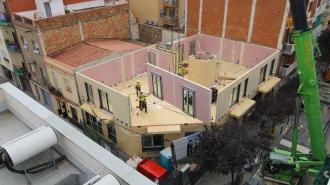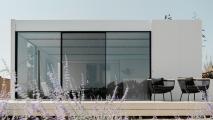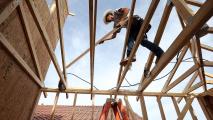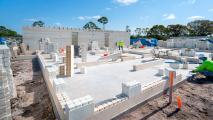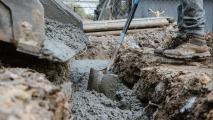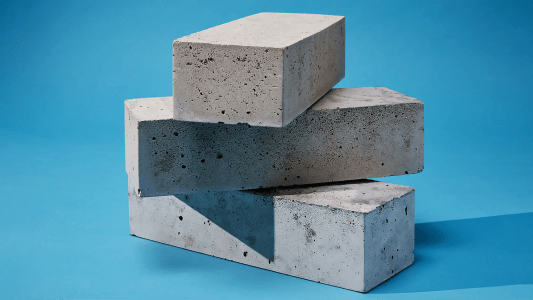Buildings are dirty. Even today, where construction sites are often home to efficient electric tools and best practices that have been honed over centuries, the modern building and construction sector is still responsible for a huge share of global energy and process-related CO2 emissions. For an industry that is trying to reach carbon neutrality by 2050, things aren’t looking good.
But there is hope. New building techniques could dramatically reduce the carbon footprint of new construction and reduce the environmental impact of a building’s entire life cycle — and one especially ingenious approach combines the virtual control of The Sims with the prefab convenience of IKEA.
Less waste, more flexibility
On a quiet street corner in Barcelona sits a modest three-story apartment building. Within its ultra-modern exterior it holds a total of eight units, each with its own balcony overlooking the street below. It’s quaint and unassuming, and as you cruise past on your moped you’d never guess that the embodied carbon of the building (i.e., the amount of carbon emitted during construction) is 81% less than a similar building built with conventional construction techniques — or that it was built in less than two-thirds the time.
That’s because before it ever existed here, in the real world, every wall, floor section, window, and railing were meticulously pieced together in a virtual building platform created by a startup called 011h. Based in Spain, 011h designs buildings around a set of preexisting components. The end result is a structure that looks and feels like any other, but it can be built faster and with a fraction of the environmental impact of traditional construction. Better still, the cost is anticipated to be cheaper over the life of the building.
011h’s proprietary platform calculates not just overall cost, but execution time, and the carbon footprint of the entire process. Everything is accounted for, right down to the number of fasteners needed to secure each component in place.
Once plans are finalized, building begins with the construction of each component — whether it be a wall, ceiling, entrance, or any other building piece — using just-in-time supply chain sourcing with an eye toward sustainability.
Standardizing construction in this way naturally reduces material waste because the only things sent to the building site are the components that will eventually make up the structure. Assembling each component of the building in a controlled environment also allows for greater flexibility in the tools and processes being used. When reducing waste and saving energy is the goal, this becomes a huge advantage.
“Mass timber” makes environmental sense
It’s easy to visualize the impact of construction on the local environment. Paving over a field or forest and replacing it with a parking lot or subdivision has an effect on the immediate area in an obvious and visible way. But it’s often the less obvious aspects of building construction that are the most problematic over the long term.
Replacing steel and concrete with wood from sustainable sources is a huge step toward decarbonizing the building sector.
Building materials, especially steel and concrete, are the most troublesome — their manufacture requires large amounts of heat, and because sustainable energy isn’t yet widely available for these industries, that energy comes from fossil fuels. As an example, creating one ton of steel releases 2.3 tons of carbon.
For this reason, 011h leans heavily on “mass timber” (engineered wood) to construct the components of its buildings. Over the past half decade, wood has seen a resurgence in the construction sector, with buildings as high as 25 stories being built primarily out of cross-laminated timber, a technique that involves arranging layers of wood boards at 90-degree angles to create large slabs that serve as support. Even though concrete is required for the slab of a mass timber building, you need less of it than in traditional construction, because the overall weight of the building is less, and foundation walls can be made from mass timber.
Environmental experts believe that replacing steel and concrete with wood from sustainable sources would be a huge step toward decarbonizing the building sector. This is one thing that separates 011h from other pre-built or modular construction companies (for example the 2-bedroom cottage available to order from Home Depot).
Deconstruction over destruction
When a conventional building has reached the end of its usable life and can’t be repurposed, it’s often torn down. It’s at this point that a mass timber structure built of prefab components — like those from 011h as well as others in the space, including Leko Labs and Plant Prefab — can really shine.
While individual circumstances may differ from building to building, prefab components that aren’t damaged don’t have to be destroyed, torn apart, or thrown away. Deconstructing a building that was built in this way allows the components to be used again in another application.
Creating a major shift in a sector as massive as the construction industry is a daunting task, and right now it’s primarily startups that are doing the heavy lifting. Still, digital design, prefab construction, and mass timber are enjoying significant momentum, and their continued success can only be good for the planet.
We’d love to hear from you! If you have a comment about this article or if you have a tip for a future Freethink story, please email us at [email protected].
